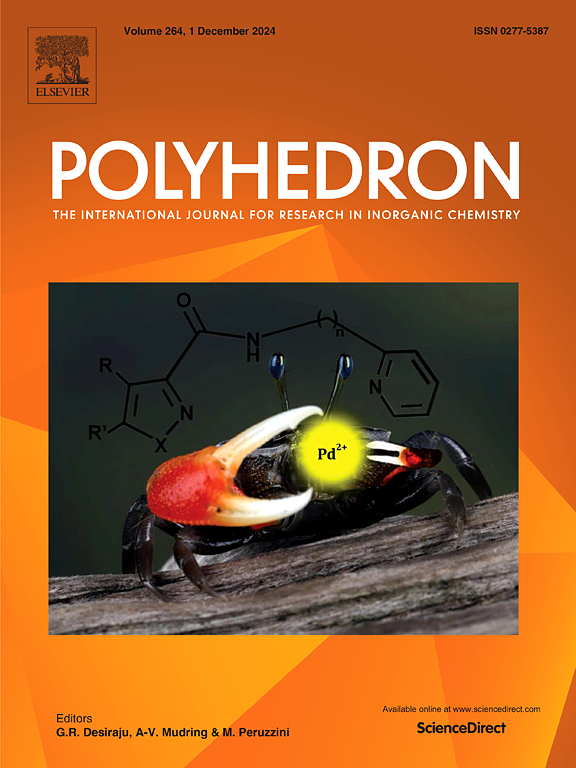Copper(II) complexes with N,O-donor azo-Schiff base ligands: Synthesis, structure, DFT studies, molecular docking, anticancer and antimicrobial activity
IF 2.4
3区 化学
Q2 CHEMISTRY, INORGANIC & NUCLEAR
引用次数: 0
Abstract
Two Schiff base ligands containing 4-(fluoro or bromo)phenylazo group 2, 3 and their Cu(II) complexes 4 and 5 were prepared, and their structures were characterized by analytical, spectral and computational methods. The crystal structures of the ligands 2, 3 and their Cu(II) complexes 4 and 5 were determined by single crystal XRD studies. The XRD data revealed that both ligands 2 and 3 are in phenol-imine tautomeric state in the crystalline form. In the structures of Cu(II) complexes 4 and 5, each Cu(II) is four coordinated binding to NO (imine nitrogen and donor set of two azo-Schiff base ligands with approximately square plane geometry. The elemental analysis data reveal that the azo-Schiff base Cu(II) complexes have 1:2 (M: L) stoichiometry. The electronic absorption spectra and quantum chemical calculations suggest a distorted square planer geometry for the complexes. Antibacterial activities of the azo-Schiff bases and their Cu(II) complexes were screened against of Bacillus cereus and Staphylococcus aureus, Escherichia coli and Salmonella typhimurium. The antitumor activity of the has been investigated across different cancer cell lines, including human breast cancer (MCF-7, MDA-MB-231), human colon colorectal adenocarcinoma (HT-29), rat glioma (C6), human Gastric Adenocarcinoma (AGS) and cisplatin was used as the standard drug. The antiproliferative efficacy of compound 5 was assessed through flow cytometry and annexin-V analysis, while the metabolic pathway active in breast cancer cells was scrutinized to understand its mechanism of action. The cytotoxic effects of synthesized ligands and their Cu(II) complexes were evaluated on multiple cancer cell lines, revealing that Cu(II) complex 5 had the highest potency against MDA-MB-231 cells with an IC50 value of 4.45 µg/mL, demonstrating significant selectivity for cancer cells over healthy cells, and indicating its potential as an effective therapeutic agent in cancer treatment, particularly as it induced cell death while minimally affecting healthy cells. Furthermore, in silico studies were conducted to evaluate the antibacterial and anticancer properties of compounds 1–5. The findings revealed that compound 5 exhibited the highest antibacterial activity against S. aureus and B. cereus, as well as significant cytotoxic effects on breast cancer cells. All in all, two Schiff base ligands containing 4-(fluoro or bromo)phenylazo group 2, 3 and their Cu(II) complexes 4, 5 hold promise as prospective candidates for the development of novel anticancer drugs.

求助全文
约1分钟内获得全文
求助全文
来源期刊

Polyhedron
化学-晶体学
CiteScore
4.90
自引率
7.70%
发文量
515
审稿时长
2 months
期刊介绍:
Polyhedron publishes original, fundamental, experimental and theoretical work of the highest quality in all the major areas of inorganic chemistry. This includes synthetic chemistry, coordination chemistry, organometallic chemistry, bioinorganic chemistry, and solid-state and materials chemistry.
Papers should be significant pieces of work, and all new compounds must be appropriately characterized. The inclusion of single-crystal X-ray structural data is strongly encouraged, but papers reporting only the X-ray structure determination of a single compound will usually not be considered. Papers on solid-state or materials chemistry will be expected to have a significant molecular chemistry component (such as the synthesis and characterization of the molecular precursors and/or a systematic study of the use of different precursors or reaction conditions) or demonstrate a cutting-edge application (for example inorganic materials for energy applications). Papers dealing only with stability constants are not considered.
 求助内容:
求助内容: 应助结果提醒方式:
应助结果提醒方式:


